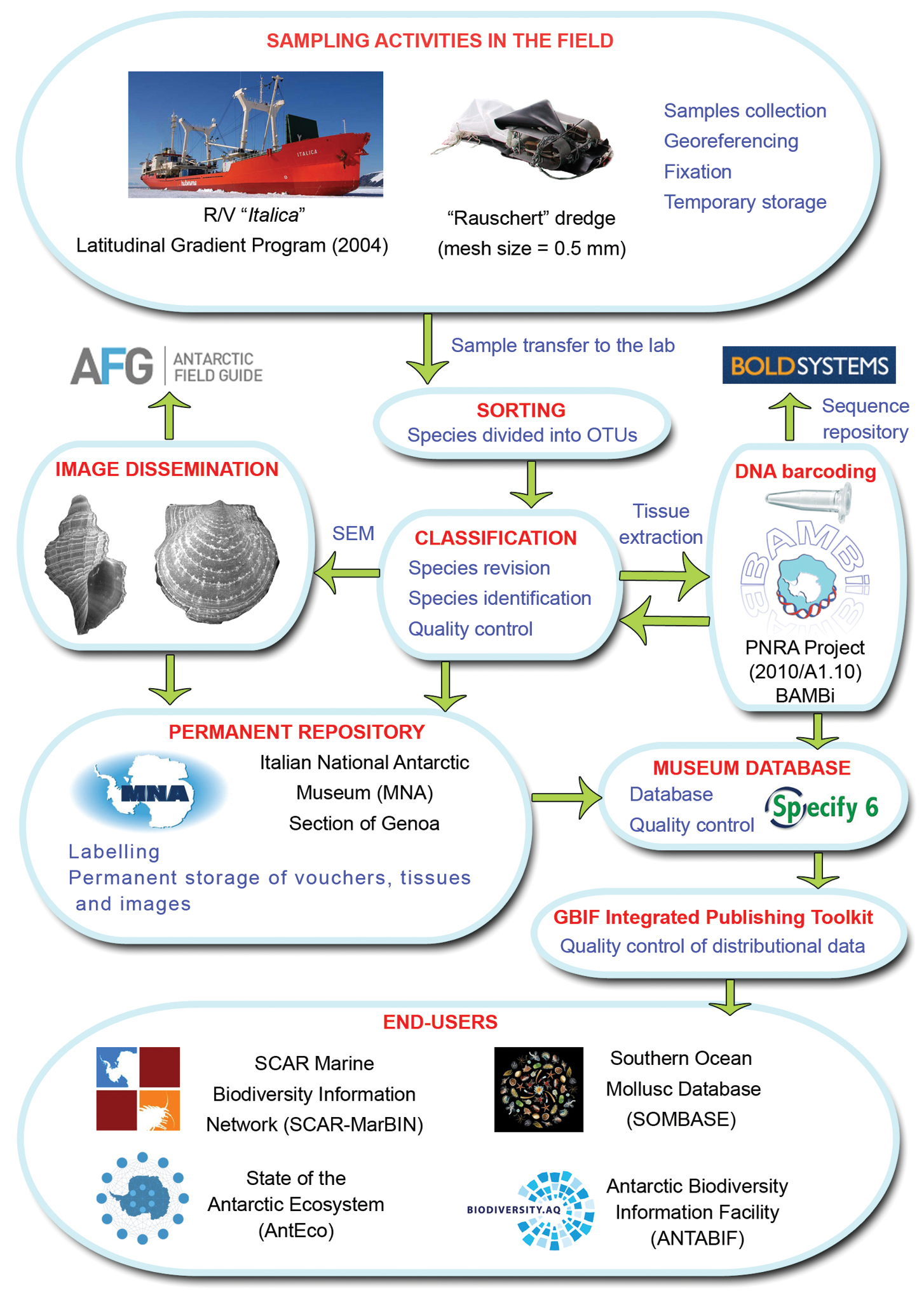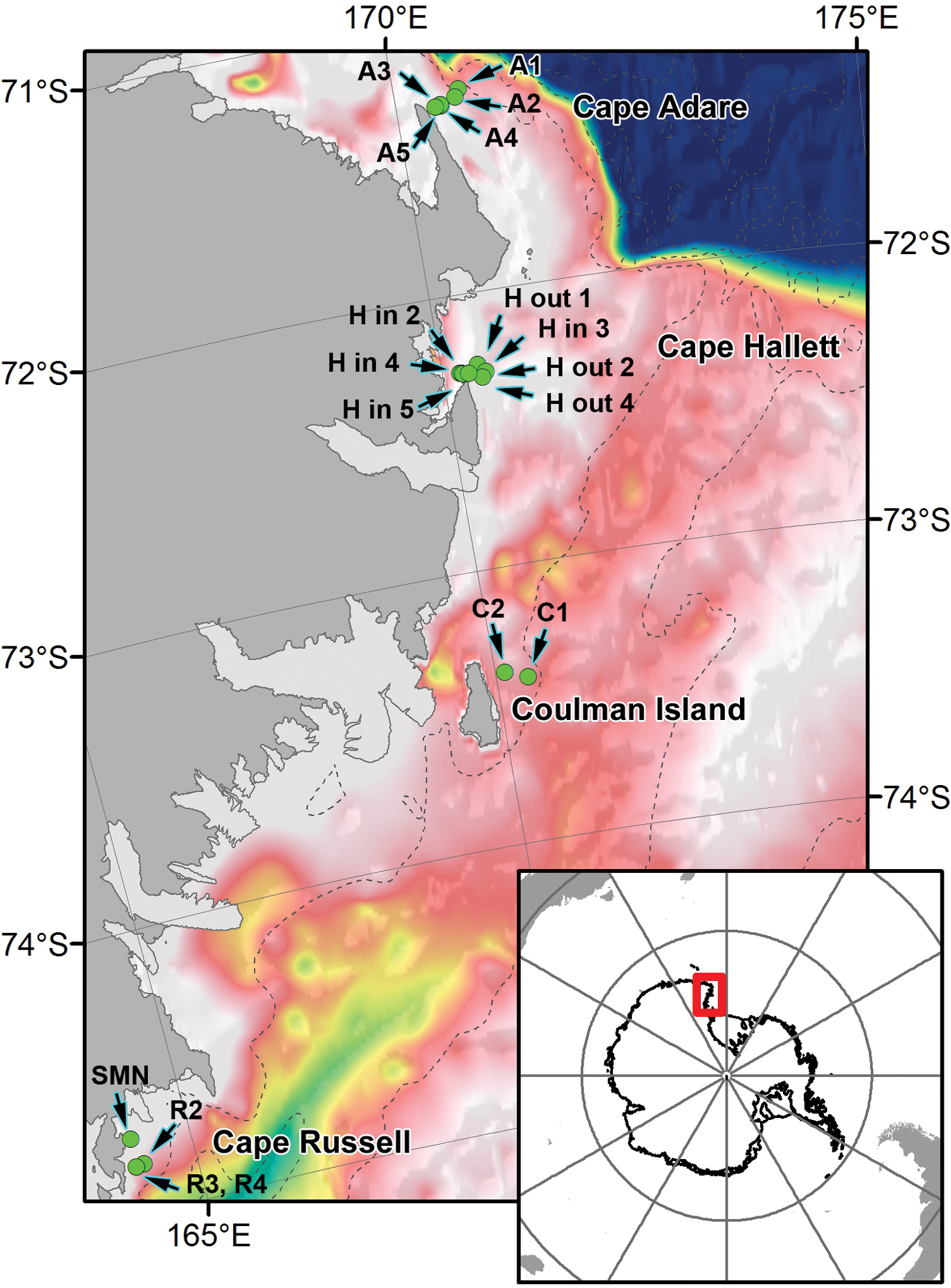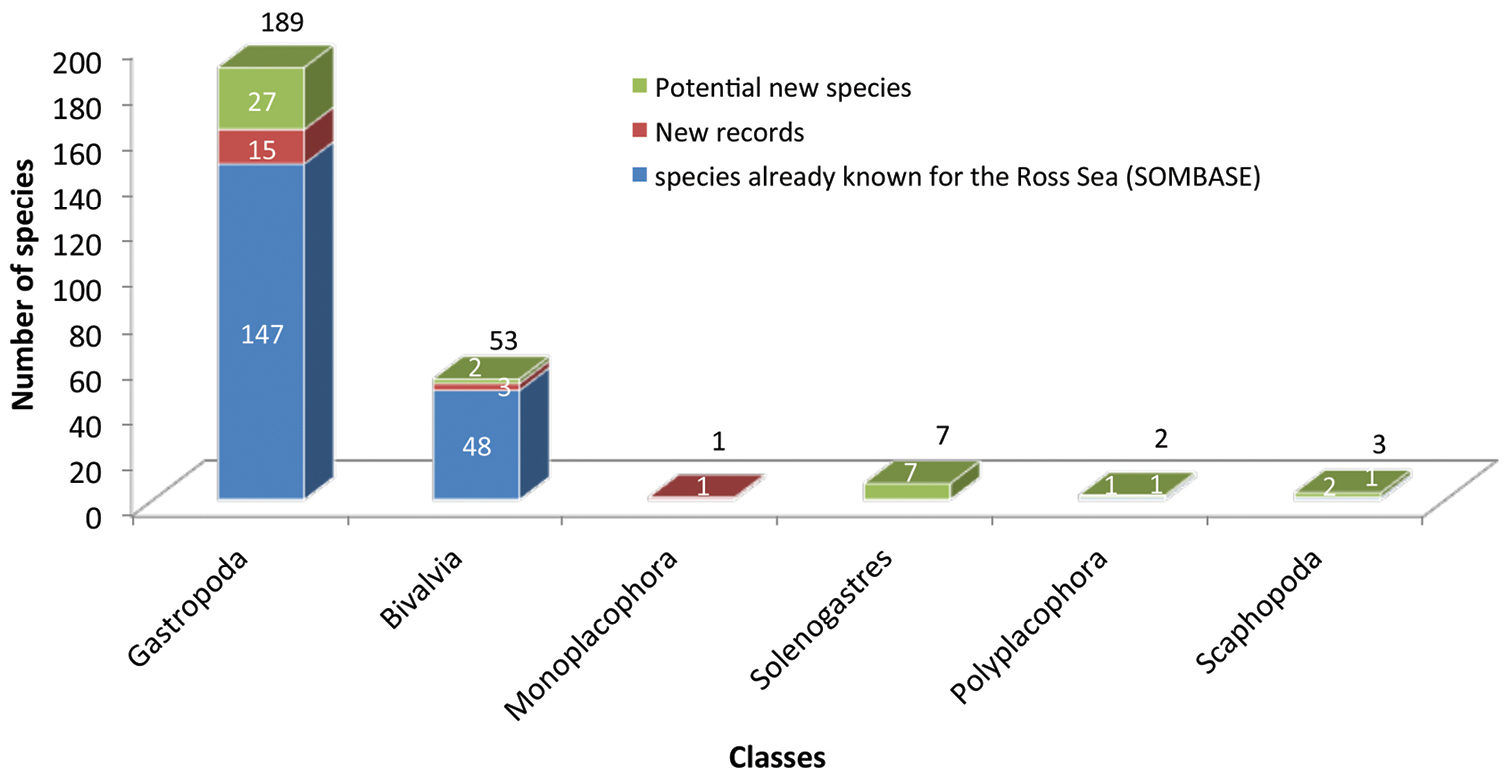






(C) 2013 Claudio Ghiglione. This is an open access article distributed under the terms of the Creative Commons Attribution License 3.0 (CC-BY), which permits unrestricted use, distribution, and reproduction in any medium, provided the original author and source are credited.
For reference, use of the paginated PDF or printed version of this article is recommended.
Citation: Ghiglione C, Alvaro MC, Griffiths HJ, Linse K, Schiaparelli S (2013) Ross Sea Mollusca from the Latitudinal Gradient Program: R/V Italica 2004 Rauschert dredge samples. ZooKeys 341: 37–48. doi: 10.3897/zookeys.341.6031 Resource ID: GBIF key: http://gbrds.gbif.org/browse/agent?uuid=6c808b65-184a-4ec2-a658-d55d5e1f9ba5
Resource citation: Italian National Antarctic Museum (2013-). Ross Sea Mollusca from the Latitudinal Gradient Program: Italica 2004 Rauschert dredge samples, 505 incidence records. Contributed by Ghiglione C, Alvaro MC, Griffiths H, Linse K, Schiaparelli S. Online at http://ipt.biodiversity.aq/manage/resource-registerResource.do, Version 1.0 (last updated on 2013-08-01), GBIF key: http://gbrds.gbif.org/browse/agent?uuid=6c808b65-184a-4ec2-a658-d55d5e1f9ba5. Data paper ID: doi: 10.3897/zookeys.341.6031
Information regarding the molluscs in this dataset is based on the Rauschert dredge samples collected during the Latitudinal Gradient Program (LGP) on board the R/V “Italica” in the Ross Sea (Antarctica) in the austral summer 2004. A total of 18 epibenthic dredge deployments/samplings have been performed at four different locations at depths ranging from 84 to 515m by using a Rauschert dredge with a mesh size of 500μm. In total 8, 359 specimens have been collected belonging to a total of 161 species. Considering this dataset in terms of occurrences, it corresponds to 505 discrete distributional records (incidence data). Of these, in order of abundance, 5, 965 specimens were Gastropoda (accounting for 113 species), 1, 323 were Bivalvia (accounting for 36 species), 949 were Aplacophora (accounting for 7 species), 74 specimens were Scaphopoda (3 species), 38 were Monoplacophora (1 species) and, finally, 10 specimens were Polyplacophora (1 species). This data set represents the first large-scale survey of benthic micro-molluscs for the area and provides important information about the distribution of several species, which have been seldom or never recorded before in the Ross Sea. All vouchers are permanently stored at the Italian National Antarctic Museum (MNA), Section of Genoa, enabling future comparison and crosschecking. This material is also currently under study, from a molecular point of view, by the barcoding project “BAMBi” (PNRA 2010/A1.10).
Antarctica, Ross Sea, Mollusca, Gastropoda, Bivalvia, Monoplacophora, Aplacophora, Polyplacophora, Scaphopoda, Italica 2004, Rauschert dredge, Latitudinal Gradient Program
This dataset is about the mollusc samples obtained in the framework of the 2004 voyage of the RV “Italica”, under the Latitudinal Gradient Program (LGP), by deploying a fine-mesh dredge (Rauschert dredge). This collection is now part of the Italian National Antarctic Museum (MNA, Section of Genova) and is published with the aim of increasing the knowledge of the distribution of mollusc species in the Ross Sea. The dataset is also the first Italian contribution to ANTABIF based on materials stored at the MNA.
Project title: Latitudinal Gradient Program (LGP) R/V “Italica” voyage 2004 - Mollusca.
Curator and Promoter: Stefano Schiaparelli.
Personnel: Claudio Ghiglione, Maria Chiara Alvaro, Huw J. Griffiths, Katrin Linse.
Funding: This study is part of the Project 2002/8.6 (“The coastal ecosystem of Victoria Land Coast: distribution and structure along a latitudinal gradient”) and of the Project 2010/A1.10 (Barcoding of Antarctic Marine Biodiversity, BAMBi) funded by the Italian National Antarctic Research Program (PNRA). Vouchers are maintained at the Italian National Antarctic Museum (MNA), Section of Genoa.
Study area description: This dataset lists the species that have been collected by deploying for the first time a Rauschert dredge in the Ross Sea (
Design description: In the past decade, the Ross Sea has been the area studied by the Latitudinal Gradient Program (LGP; www.lgp.aq) which aimed at: i) understanding the complex ecosystems that exist along the Victoria Land coast; and ii) determining the effects of environmental change on these ecosystems; iii) maximising the transfer of information and ideas, by utilising joint logistic facilities. To achieve these targets, two temporally parallel research voyages took place during the Austral summer 2004: one on board the Italian R/V “Italica” and one on board the R/V “Tangaroa” (“BioRoss” voyage, TAN0402) organized, respectively, by NIWA (National Institute of Water and Atmospheric Research, Wellington) and PNRA (Antarctic National Research Project).
In the field, samples were collected by using a Rauschert dredge with a mesh size of 500μm (
Flowchart depicting major steps in dataset development and publishing.
Map of sampling stations.
The material was collected during the R/V “Italica” 2004 LGP Expedition by Dr. Peter Rehm (see
The present molluscs dataset has been formatted in order to fulfil the standards (Darwin Core) required by the OBIS scheme (http://iobis.org/data/schema-and-metadata) according the SCAR-MarBIN Data Toolkit (available at http://www.scarmarbin.be/documents/SM-FATv1.zip). The dataset was uploaded in the ANTOBIS database (the geospatial component of SCAR-MarBIN) and added to SOMBASE (Southern Ocean Mollusc Database, www.antarctica.ac.uk/sombase). SOMBASE generated initial core data system upon which SCAR’s Marine Biodiversity Information Network (SCAR-MarBIN) was built. Taxonomy was matched against the Register of Antarctic Marine Species, using the Taxon Match tool (http://www.scarmarbin.be/rams.php?p=match). Data from both the R/V “Italica” and the R/V “Tangaroa” (“BioRoss”, TAN0402) voyages were published in
Study extent: This dataset lists the species that have been collected by deploying for the first time a Rauschert dredge in the Ross Sea (
Sampling description: Sampling activities were done in four main areas of the Ross Sea: Cape Adare, Cape Hallett, Coulman Island, Cape Russell (Fig. 2). The eighteen Rauschert dredge samples were obtained at Cape Adare (five sampling sites: A1, A2, A3, A4, A5), at Cape Hallett (seven sampling sites: H out 1, H out 2, H out 4, H in 2, H in 3; H in 4, H in 5), at Coulmann Island (two sites: C1, C2) and at Cape Russell (four sites: SMN, R2, R3, R4) (
Quality control description: Specimens were classified at the lowest possible taxonomic level. A 18% of species were classified at the or above the generic level due to an uncertainty about their status. The same was for another 6% of species that potentially represent new species. Although these taxa will require further studies (e.g. morphological and genetic, currently underway) these have been included in this dataset as they could be clearly distinguished during sorting activities and were therefore considered as morphospecies. During all the phases of sorting, classification and storage of samples at the Italian National Antarctic Museum, quality controls and data cleaning have been undertaken at various steps in order to produce quality data and make consistent cross-references between the database and samples’ labels. The MNA uses an SQL-based database (Specify 6) to manage its collections and link all the data (photos, sequences, etc.) to the physical samples. Georeferencing on board the R/V “Italica” is based on the interpolation of GPS satellite receivers (models 3S Navigation and Glonass ASHTECH GG24) and a gyrocompass. Station coordinates and sampling events were recorded during sampling activities through the “Italica” NetNav WEB system, which is based on the above GPS systems.
General taxonomic coverage description: The present dataset focuses on the Kingdom Animalia, Phylum Mollusca and includes six molluscs classes: Gastropoda, Bivalvia, Monoplacophora, Solenogastres, Polyplacophora and Scaphopoda. In total 8, 359 specimens have been collected belonging to 161 species and corresponding to 505 species distributional records. Of these, in order of abundance, 5, 965 specimens were Gastropoda (accounting for 113 species), 1, 323 were Bivalvia (accounting for 36 species), 949 were Aplacophora (accounting for 7 species), 74 specimens were Scaphopoda (3 species), 38 were Monoplacophora (1 species) and, finally, 10 specimens were Polyplacophora (1 species). This data set represent the first large-scale survey of benthic micromolluscs for the area and provides important information about the distribution of several species which have been seldom or never recorded before in the Ross Sea. A detailed analysis of the distribution of mollusc species sampled by the Rauschert dredge as well as the illustration of all new records for the Ross Sea is in
Number of new species records compared to the available baseline (SOMBASE, www.antarctica.ac.uk/sombase). In light blue: species already known for the Ross Sea; in red: new record of know species never found before in the Ross Sea; in green: species classified at the generic level only a potentially representing new species for the area.
The dataset includes respectively for each class:
Kingdom: Animalia
Phylum: Mollusca
Class: Solenogastres
Family: Neomeniidae
Species: Solenogastres sp. 1, Solenogastres sp. 2, Solenogastres sp. 3, Solenogastres sp. 4, Solenogastres sp. 5, Solenogastres sp. 6, Neomenia sp. 1
Kingdom: Animalia
Phylum: Mollusca
Class: Polyplacophora
Family: Callochitonidae
Genus: Callochiton
Species: Callochiton sp. 1
Kingdom: Animalia
Phylum: Mollusca
Class: Monoplacophora
Family: Micropilinidae
Genus: Micropilina
Species: Micropilina arntzi Warén & Hain, 1992
Kingdom: Animalia
Phylum: Mollusca
Class: Gastropoda
Family: Acteonidae, Cancellaridae, Anatomidae, Margaritidae, Doridae, Eulimidae, Mangeliidae, Seguenzioidea, Calliotropidae, Capulidae, Newtoniellidae, Buccinidae, Skeneidae, Cylichnidae, Diaphanidae, Dotidae, Eatoniellidae, Zerotulidae, Lepetidae, Naticidae, Cerithiopsidae, Collonidae, Skeneidae, Mangellidae, Margaritidae, Orbitestellidae, Triviidae, Omalogyridae, Volutomitridae, Buccinidae, Philinidae, Raphitomidae, Rissoidae, Akiodorididae, Cingulopsidae, Pyramidellidae, Tjaernoeiidae, Muricidae, Mathildidae, Borsoniidae
Genus: Acteon, Admete, Aegires, Anatoma, Antimargarita, Antistreptus, Austrodoris, Bathycrinicola, Belalora, Brookula, Calliotropis, Capulus, Cerithiella, Chlanidota, Cirsonella, Cylichna, Diaphana, Doto, Eatoniella, Eumetula, Frovina, Fusceulima, Haliella, Hemiaclis, Iothia, Kerguelenatica, Krachia, Leptocollonia, Liotella, Lissotesta, Lorabela, Margarites, Melanella, Microdiscula, Newnesia, Nothoadmete, Notoficula, Omalogyra, Paradmete, Pareuthria, Philine, Pleurotomella, Powellisetia, Probuccinum, Prodoridunculus, Prosipho, Sinuber, Skenella, Streptocionella, Thjaernoeia, Toledonia, Torellia, Trilirata, Trophon, Turritellopsis, Typhlodaphne
Species: Acteon antarcticus Thiele, 1912, Admete haini Numanami, 1996, Aegires albus Thiele, 1912, Anatoma euglypta (Pelseneer, 1903), Antimargarita dulcis (E. A. Smith, 1907), Doris kerguelensis (Bergh, 1884), Bathycrinicola tumidula (Thiele, 1912), Oneopota striatula (Thiele, 1912), Bertellidae sp.1, Bertellidae sp.2, Brookula pfefferi Powell, 1951, Brookula cf. argentina Zelaya, Absalao & Pimienta, 2006, Brookula strebeli A.W.B. Powell, 1951, Calliotropis antarctica Dell, 1990, Cancellaridae sp.1, Cancellaridae sp.2, Capulus subcompressus Pelseneer, 1903, Cerithiella seymouriana (Strebel, 1908), Chlanidota signeyana A.W.B. Powell, 1951, Cirsonella extrema Thiele, 1912, Cylichna gelida (E. A. Smith, 1907), Diaphana paessleri (Strebel, 1905), Doto antarctica Eliot, 1907, Doto sp., Eatoniella aff. cana Ponder, 1983, Eatoniella cf. demissa (E. A. Smith, 1915), Eatoniella kerguelensis (E. A. Smith, 1875), Eulimidae sp.1, Eulimidae sp.2, Eulimidae sp.3, Eulimidae sp.4, Eulimidae sp.5, Eumetula dilecta (Thiele, 1912), Eumetula cf. dilecta (Thiele, 1912), Eumetula strebeli (Thiele, 1912), Frovina sp.1, Frovina sp.2, Fusceulima sp.1, Fusceulima sp.2, Gastropoda sp.1, Haliella sp.1, Hemiaclis incolorata (Thiele, 1912), Hemiaclis sp.1, Hemiaclis sp.2, Iothia emarginuloides (Philippi, 1868), Kerguelenatica delicatula (E. A. Smith, 1902), Krachia antartica (E. A. Smith, 1907), Leptocollonia innocens (Thiele, 1912), Liotella sp.1, Lissotesta macknighti (Dell, 1990), Lissotesta mammillata (Thiele, 1912), Lissotesta minutissima (E. A. Smith, 1907), Lissotesta notalis (Strebel, 1908), Lissotesta similis (Thiele, 1912), Lissotesta sp.1, Lissotesta strebeli (Thiele, 1912), Lissotesta unifilosa (Thiele, 1912), Lorabela davisi (Hedley, 1916), Margarites crebrilirulata (E. A. Smith, 1907), Margarites refulgens (E. A. Smith, 1907), Marseniopsis sp., Melanella antarctica (Strebel, 1908), Melanella convexa (E. A. Smith, 1907), Microdiscula vanhoeffeni Thiele, 1912, Naticidae sp.1, Newnesia antartica E. A. Smith, 1902, Nothoadmete cf. delicatula (E. A. Smith, 1907), Notoficula bouveti (Thiele, 1912), Omalogyra burdwoodiana Strebel, 1908, Omalogyra sp.1, Onoba egorovae Numanami, 1996, Onoba gelida (E. A. Smith, 1907), Onoba kergueleni (E. A. Smith, 1875), Onoba paucilirata (Melvill & Standen, 1912), Onoba sp.1, Onoba subantarctica wilkesiana (Hedley, 1916), Onoba turqueti (Lamy, 1905), Paradmete fragillima (Watson, 1882), Pareuthria plicatula Thiele, 1912, Philine alata Thiele, 1912, Pleurotomella deliciosa Thiele, 1912, Powellisetia deserta (E. A. Smith, 1907), Probuccinum tenerum (E. A. Smith, 1907), Prodoridunculus gaussianus Thiele, 1912, Prosipho nodosus Thiele, 1912, Antistreptus contrarius (Thiele, 1912), Prosipho glacialis Thiele, 1912, , Prosipho mundus E. A. Smith, 1915, Sinuber microstriatum Dell, 1990, Skenella paludinoides (E. A. Smith, 1902), Streptocionella pluralis Dell, 1990, Tjaernoeia michaeli Engl, 2002, Toledonia cf. perplexa Dall, 1902, Toledonia elata Thiele, 1912, Toledonia globosa Hedley, 1916, Toledonia limnaeaeformis (E. A. Smith, 1879), Toledonia major (Hedley, 1911), Toledonia palmeri Dell, 1990, Toledonia punctata Thiele, 1912, Toledonia sp.1, Toledonia sp.2, Toledonia sp.3, Toledonia striata Thiele, 1912, Torellia antarctica (Thiele, 1912), Torellia exilis (Powell, 1958), Trilirata macmurdensis (Hedley, 1911), Trilirata sexcarinata Warén & Hain, 1996, Trophon coulmanensis E. A. Smith, 1907, Trophon minutus Melvill & Standen, 1907, Turritellopsis latior Thiele, 1912, Typhlodaphne innocentia Dell, 1990, Typhlodaphne sp.1
Kingdom: Animalia
Phylum: Mollusca
Class: Bivalvia
Family: Philobryidae, Astartidae, Cuspidariidae, Cyamiidae, Carditidae, Cyclochlamydidae, Propeamussiidae, Mytilidae, Kelliidae, Limidae, Limopsidae, Philibryidae, Lyonsiidae, Montacutidae, Poromyidae, Nuculanidae, Siliculidae, Cuspidariidae, Thraciidae, Thyasiridae, Galeommatoidea, Yoldiidae
Genus: Adacnarca, Astarte, Cuspidaria, Cyamiomactra, Cyclocardia, Cyclochlamys, Cyclopecten, Dacrydium, Kellia, Limatula, Limopsis, Lissarca, Lyonsia, Montacuta, Mysella, Parathyasira, Philobrya, Poromya, Propeleda, Pseudokellya, Silicula, Subcuspidaria, Thracia, Waldo, Yoldiella
Species: Adacnarca nitens Pelseneer, 1903, Astarte longirostris d’Orbigny, 1842, Cuspidaria tenella E. A. Smith, 1907, Cuspidaria kerguelensis (E. A. Smith, 1885), Cyamiomactra laminifera (Lamy, 1906), Cyamiomactra robusta Nicol, 1964, Cyclocardia astartoides (Martens, 1878), Cyclochlamys gaussiana (Thiele, 1912), Cyclochlamys pteriola (Melvill & Standen, 1907), Dacrydium albidum Pelseneer, 1903, Kellia simulans E. A. Smith, 1907, Limatula hodgsoni (E. A. Smith, 1907), Limatula ovalis (Thiele, 1912), Limatula simillima (Thiele, 1912), Limopsis lilliei E. A. Smith, 1915, Limopsis marionensis E. A. Smith, 1885, Lissarca notorcadensis Melvill & Standen, 1907, Lyonsia arcaeformis Martens, 1885, Montacuta nimrodiana Hedley, 1911, Mysella cf. antarctica (E. A. Smith, 1907), Mysella charcoti Lamy, 1906, Mysella gibbosa (Thiele, 1912), Mysella sp.1, Philobrya sublaevis Pelseneer, 1903, Philobrya wandelensis Lamy, 1906, Philobrydae sp.1, Poromya spinosula Thiele, 1912, Propeleda longicaudata (Thiele, 1912), Pseudokellya gradate Thiele, 1912, Pseudokellya sp. juv., Silicula rouchi Lamy, 1911, Thracia meridionalis E. A. Smith, 1885, Parathyasira dearborni (Nicol, 1965), Thyasira debilis (Thiele, 1912), Waldo parasiticus (Dall, 1876), Yoldiella antarctica (Thiele, 1912)
Kingdom: Animalia
Phylum: Mollusca
Class: Scaphopoda
Family: Pulsellidae, Gadilidae
Genus: Pulsellum, Siphonodentalium
Species: Pulsellum sp. 1, Siphonodentalium dalli (Pilsbry & Sharp, 1898), Siphonodentalium sp. 1
Parent collection identifier: Italian Antarctic National Museum (Section of Genoa, Italy)
Collection name: Italica 2004 Rauschert Molluscs
Collection identifier: http://www.mna.it
Specimen preservation method: Specimens were fixed in pre-cooled Ethanol immediately after the extraction from the dredge net. In this way any thermal shock which could potentially alter the integrity of DNA was avoided. After fixation, specimens were sorted under a stereomicroscope, divided into morphospecies and stored in „Screw Thread Vials“ (National Scientific, USA). For study, some specimens per species have been dissected under the stereomicroscope and soft parts used for DNA extractions. Shells corresponding to these specimens have been dried in increasing ethanol concentrations, mounted on stubs and gold sputtered for scanning electron microscope observation. These specimens are maintained in a laboratory kiln with silica gel to prevent deterioration. All the other specimens are kept in ethanol in the collections of the Italian National Antarctic Museum.
This dataset contains data about the Phylum Mollusca in the Ross Sea. In particular, it includes 161 species for a total of 8, 359 specimens. By cconsidering this dataset in terms of incidence, it encompasses 505 discrete distributional records.
The Darwin Core elements included in the dataset are: scientific name, collection code (i.e. MNA acronym), catalogue number (i.e. MNA catalogue number), year of collection, date of collection, latitude and longitude (in decimal degrees), individual counts, and basis of records (type of preservation).
Object name: Italica 2004_Rauschert dredge_Ross_sea_Mollusca_lgp
Character encoding: UTF-8
Format name: Darwin Core Archive format
Format version: 1.0
Distribution: http://ipt.biodiversity.aq/resource.do?r=ross_sea_mollusca_lgp
Language: English
Metadata language: English
License of use: This dataset [Italica 2004_Rauschert dredge_Ross_sea_Mollusca_lgp] is made available under the Open Data Commons Attribution License: http://www.opendatacommons.org/licenses/by/1.0/
Date of metadata creation: 2013-01-08
Hierarchy level: Dataset


